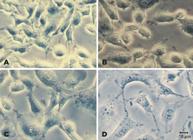ABSTRACT
Purpose:
The present study aimed to investigate the inhibitory effect of fluorofenidone against transforming growth factor β2-induced proliferation and epithelial-mesenchymal transition in human lens epithelial cell line FHL 124 and its potential mechanism.
Methods:
We evaluated the effect of fluorofenidone on proliferation and epithelial-mesenchymal transition of human lens epithelial cell line FHL 124 in vitro. After treatment with 0, 0.1, 0.2, 0.4, 0.6, and 1.0 mg/mL fluorofenidone, cell proliferation was measured via MTT assay. Cell viability was evaluated by lactate dehydrogenase activity from damaged cells. FHL 124 cells were treated with different transforming growth factor β2 concentrations (0-10 ng/mL) for 24 h and the expression of CTGF, α-SMA, COL-I, E-cadherin, and Fn were detected via quantitative polymerase chain reaction and Western blot analysis. After treatment with 0, 0.2, and 0.4 mg/ml fluorofenidone, the expressions of transforming growth factor β2 and SMADs were detected with real-time polymerase chain reaction and Western blot analysis. Expressions of CTGF, α-SMA, COL-I, and Fn were analyzed by immunocytochemistry assay.
Results:
The viability of FHL 124 cells was not inhibited when the fluorofenidone concentration was ≤0.4 mg/mL after the 24h treatment. Cytotoxicity was not detected via lactate dehydrogenase assay after the 24h and 36h treatment with 0.2 and 0.4 mg/mL fluorofenidone. Transforming growth factor β2 increased mRNA and protein expression of CTGF, α-SMA, COL-I, and Fn. However, fluorofenidone significantly suppressed expression of SMADs, CTGF, α-SMA, COL-I, and Fn in the absence or presence of transforming growth factor β2 stimulation.
Conclusions:
Fluorofenidone significantly inhibited expression of SMADs, CTGF, α-SMA, COL-I, and Fn in FHL 124 cells. Due to noncompliance in infants, fluorofenidone may become a novel therapeutic drug against posterior capsular opacification in infants.
Keywords:
Transforming growth factor beta2; Fluorofenidone; Lens; Cataract; Infant

 Thumbnail
Thumbnail
 Thumbnail
Thumbnail
 Thumbnail
Thumbnail
 Thumbnail
Thumbnail
 Thumbnail
Thumbnail
 Thumbnail
Thumbnail





